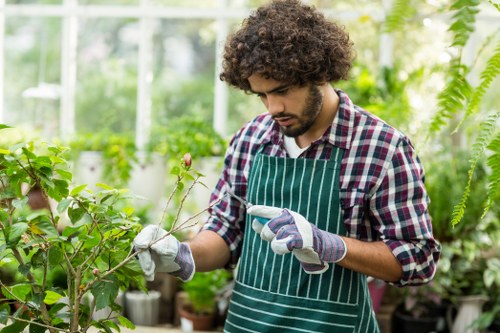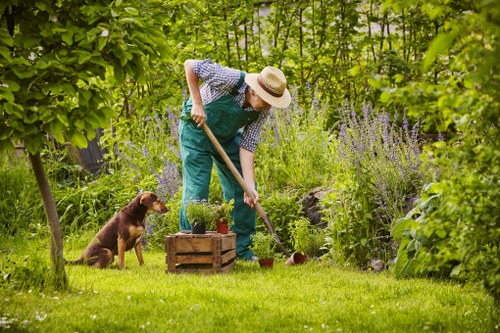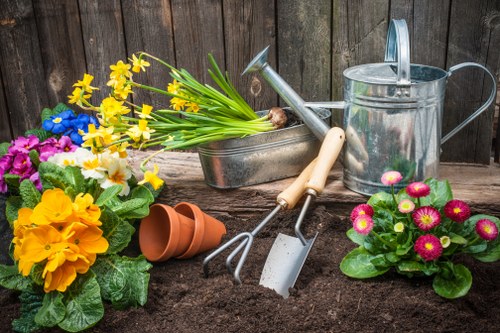Gardeners Hook: Unleashing the Secrets of a Thriving Garden Life

Gardeners Hook is not just a concept but a philosophy that bridges the natural world with the art of gardening. Over decades, enthusiasts and experts have developed unique methods to blend tradition with modern horticulture, creating spaces that nurture growth and inspire creativity. This article invites you to explore the multifaceted world of Gardeners Hook, where every element is designed to spark inspiration in garden lovers of all ages.
In today’s fast-paced world, spending time outdoors has become both a necessity and a luxury. Gardeners Hook exemplifies how cultivating a green space can uplift spirits and offer a meditative escape from daily stress. Its approach embraces sustainable practices, organic gardening techniques, and innovative design solutions that are accessible to beginners and veterans alike.
At its core, Gardeners Hook is all about connecting with nature. Whether you have a small balcony garden or a sprawling backyard, the principles of Gardeners Hook can transform your space. With a blend of science and artistry, this method encourages gardeners to experiment with textures, colors, and plant varieties while using simple hooks and supports to optimize growth and aesthetics.

History of Gardeners Hook dates back to early agricultural traditions when communities first discovered that strategic placement of garden tools and supports could lead to improved yields. Early farmers used rudimentary hooks and stakes to support climbing plants like beans and tomatoes, setting the foundation for many modern gardening techniques. These early practices have been refined over time into a sophisticated approach that today’s garden enthusiasts celebrate.
The evolution of Gardeners Hook is a story of innovation meeting nature. From experimenting with different structural supports to develop resilient green spaces, practitioners have continuously adapted the techniques to cope with urban settings, climate changes, and varying soil conditions. Historians of horticulture note that these small adjustments have led to remarkable changes in garden productivity and beauty.
Across the globe, gardening experts have embraced the Gardeners Hook philosophy. In regions where space is limited, such as urban cantilevers or suburban terraces, this technique has proven invaluable. It provides ideas for efficient plant support systems using simple hooks, trellises, and vertical garden installations, ensuring that every inch of space is maximized.

Understanding the Gardeners Hook Philosophy
This gardening technique revolves around the concept of using hooks as both functional supports and decorative elements. The principle is simple: if a plant has something to grasp, it will grow better. Gardeners Hook promotes the idea that structured support systems help plants grow upward, ultimately creating charming, natural displays. This method is beneficial because it encourages healthy growth and offers a visually appealing layout for your garden.
Central to the Gardeners Hook method is the understanding that every hook has a dual purpose: practicality and decor. The hooks used in these gardening systems come in various forms—rustic metal, resilient plastic, or even biodegradable materials—demonstrating that sustainability and aesthetics can go hand in hand.
The Role of Structure in Garden Success
In many gardens, support systems are viewed as mere accessories. However, the Gardeners Hook philosophy argues that these structural elements are critical to fostering an environment where plants can thrive. By strategically placing hooks and supports, gardeners ensure that climbing plants like peas, cucumbers, or flowering vines receive the guidance they require.
Implementing Gardeners Hook in Your Garden
To successfully integrate Gardeners Hook principles into your garden, it is essential to start with an evaluation of your space. Consider the amount of sunlight, type of soil, and the overall environment when selecting plants and support systems.Here are a few practical steps:
- Assess Your Space: Identify areas that can benefit from vertical growth and where hooks can serve both a decorative and structural purpose.
- Select Suitable Plants: Choose species known for their climbing abilities, such as beans, cucumbers, or ivy, to maximize the benefits of the hook system.
- Install Hooks Strategically: Place hooks in areas where support is needed most, ensuring that each plant has a dedicated path for growth.
- Combine Aesthetics with Utility: Opt for hooks that complement the overall design of your garden, turning them into art pieces as well as functional tools.
Adapting your garden design to incorporate these supports can transform both the visual appeal and health of your plants. Additionally, using a combination of natural supports such as bamboo stakes alongside modern hooks helps maintain an organic ambiance.

The Impact of Gardeners Hook on Modern Horticulture
Gardeners Hook has transcended traditional gardening methods by revolutionizing how both amateur and professional gardeners approach their craft. It has become an inspirational tool in garden design, enabling practitioners to think outside the box when faced with limited space or challenging growing conditions.Modern horticulture has embraced the principles of sustainability and efficient space utilization, a testament to the importance of methods like Gardeners Hook. This approach is not only eco-friendly, but it also promotes a connection to nature by encouraging gardeners to experiment and innovate. As a result, gardens that employ these techniques often become a blend of art, science, and personal expression.
Today, Gardeners Hook inspires a wide range of applications—from home gardens in small apartments to expansive community gardens. Educators, environmentalists, and hobbyists continue to explore its potential, making it a vibrant part of the growing trend towards sustainable living.

The Science Behind Gardeners Hook
Research in plant biology has shown that structural supports can significantly improve growth rates and yield. When a plant is provided with a secure climbing structure, it expends less energy stabilizing itself and more on producing blossoms and fruit. Gardeners Hook taps into this natural principle, suggesting that well-placed supports result in healthier and more robust plant growth.Scientific studies have demonstrated that vertical growth encouraged by Gardeners Hook methods allows for better air circulation, reduced risk of disease, and more efficient use of space. Organic growth supported by these practices not only augments aesthetic appeal but also contributes to environmental sustainability.
This approach is particularly beneficial for urban gardeners who might be limited by available horizontal space. By utilizing vertical supports strategically, Gardeners Hook enables users to create lush green spaces even in smaller areas, making it an ideal solution for modern living.

Sustainability and Eco-Friendly Practices
Sustainability is at the heart of the Gardeners Hook philosophy. Sustainable gardening practices are more than a trend—they are a necessity in today’s climate-conscious world. By using recycled materials for hooks, biodegradable supports, and organic fertilizers, garden enthusiasts can reduce their environmental footprint while still achieving stunning results.Eco-friendly gardening is not only about producing a beautiful garden; it’s also about reducing waste and preserving natural resources. Gardeners Hook encourages practices that nurture the soil, conserve water, and promote biodiversity within garden ecosystems.
Whether you are a hobbyist or an advanced gardener, embracing sustainability in your garden design can make a significant difference. This environmentally conscious approach helps reduce dependency on chemical interventions and fosters a healthier, more natural garden ecosystem.

Practical Tips for Gardeners Embracing the Hook Method
For gardeners new to the concept of Gardeners Hook, it is important to begin with manageable steps. Start small by identifying one or two areas in your garden that could benefit from vertical growth and applying simple, cost-effective hooks.Here are some practical tips to help you get started:
- Plan Your Layout: Map out your garden beds and note where plants will benefit most from added support.
- Invest in Quality Hooks: Whether using metal, wood, or biodegradable materials, choose supports that match your garden’s aesthetic and environmental needs.
- Monitor Plant Progress: As your plants grow, observe how they interact with the hooks and adjust accordingly.
- Learn from Others: Join local or online gardening communities to exchange tips and experiences related to Gardeners Hook.
Remember that gardening is an iterative process. Making adjustments as your garden evolves is key to a thriving outdoor space.

Creative Design Ideas with Gardeners Hook
One of the most exciting aspects of Gardeners Hook is its versatility in design. Gardeners can use the method to create living partitions, vertical vegetable gardens, or even art installations in natural settings. The flexible nature of hooks allows for creative reinterpretations of standard garden designs.Integrate colorful hanging planters along with traditional garden beds to add depth and dynamism. Combining this with carefully selected plant species creates a pleasing visual rhythm and can serve as a conversation starter during social gatherings.
Additionally, consider mixing traditional wooden trellises with modern metal hooks to strike a balance between rustic and contemporary styles. Using varied materials can add texture and contrast, further enhancing the overall charm of your garden.

How to Maintain a Gardeners Hook System
Like any garden design, maintenance is crucial to keep the Gardeners Hook system functioning optimally. Regular upkeep, such as cleaning supports, trimming overgrown branches, and repositioning hooks, ensures that your garden remains both beautiful and productive.Maintenance Tips:
- Inspect hooks periodically for signs of rust or wear.
- Prune plants to prevent overcrowding and ensure proper growth.
- Adjust hooks and supports as needed to accommodate new growth.
- Use organic treatments to prevent fungal and insect infestations.
Taking the time to care for your Gardeners Hook system can yield significant rewards, transforming a simple garden into a sustainable, thriving ecosystem.

Local Relevance: Areas Closest to Hook
For many gardeners, local relevance plays a key role in the appeal of Gardeners Hook. Understanding the geographical influence around Hook can provide valuable insights into soil type, climate, and even local gardening trends. In this section, we explore 12 nearby areas that uniquely contribute to the Gardeners Hook experience.North Hook: Located just north of the central area, North Hook is known for its rich soil and brisk breezes that help aerate the earth naturally.
East Hook: With a backdrop of sunrise vistas, East Hook has a reputation for organic gardens that emphasize sustainable practices and local flora.

South Hook: Situated in a warmer microclimate, South Hook encourages the growth of tropical and Mediterranean plants, making it an ideal testing ground for experimental garden designs.
West Hook: West Hook is celebrated for its community gardens and its vibrant exchange of gardening ideas. Local experts often share tips on harnessing Gardeners Hook techniques to maximize space and beauty.
Central Hook: As the focal point of the region, Central Hook embraces a blend of modern and traditional horticulture. It acts as a hub for workshops and local gardening events focused on the Gardeners Hook philosophy.

Old Hook: Rich with history, Old Hook features time-honored gardening traditions. Its gardens exude a classic charm that reflects the original practices of using hooks for plant support.
New Hook: Marking a contrast to its older counterpart, New Hook offers contemporary designs and innovative green technologies, making it a popular spot for urban gardeners.
Gardeners Corner: As the name suggests, Gardeners Corner is a meeting point for enthusiasts. Here, events and demonstrations related to the Gardeners Hook system are common, attracting a diverse crowd of hobbyists and professionals alike.

Green Hook: Known for its lush landscapes and eco-friendly practices, Green Hook is a prime example of how Gardeners Hook can inspire sustainable living and community involvement.
Sunny Hook: Emphasizing bright and vibrant plantings, Sunny Hook benefits from abundant sunlight and is ideal for gardeners looking to experiment with colorful blooms and diverse species.
River Hook: Positioned near a natural water source, River Hook boasts gardens that seamlessly integrate sustainability with natural water conservation techniques, a perfect match for Gardeners Hook’s principles.

Meadow Hook: Surrounded by open fields and natural meadows, Meadow Hook offers a serene environment for the cultivation of native plants and wildflowers influenced by organic gardening techniques.
Each of these areas contributes uniquely to the Gardeners Hook ethos. Their proximity to the central concept promotes a dynamic exchange of ideas, techniques, and inspiration that enrich the community of garden enthusiasts.
Local events, farmer’s markets, and community gardening days abound in these areas, making them ideal locations for gardeners to experience the full benefits of Gardeners Hook in practice. The cultural, climatic, and natural differences among these areas provide a fascinating platform for testing, modifying, and perfecting the Gardeners Hook approach.

Integrating Technology with Gardeners Hook
In an era where technology is an integral part of everyday life, modern gardeners have found innovative ways to blend digital tools with traditional Gardeners Hook methods. From automated watering systems to smartphone apps that track plant growth, technology is enhancing the efficiency and aesthetics of garden management.Gardeners can now monitor environmental conditions in real-time, ensuring that their hooked plants receive optimal conditions for growth. This integration of tech not only simplifies the garden maintenance process but also makes gardening more accessible for those with limited time.
In addition, online communities and virtual workshops allow enthusiasts to share their successes and challenges with the Gardeners Hook system, reinforcing the global network of sustainable gardening practices.

Future Trends in Gardeners Hook
As we look forward, the future of Gardeners Hook appears promising. Innovations in sustainable materials, eco-friendly support systems, and advanced cultivation techniques are all on the horizon. Researchers and garden designers are continuously experimenting with new ways to optimize plant support that are both environmentally friendly and cost-effective.The trend toward urban gardening and vertical green spaces is expected to drive further development in Gardeners Hook methodologies. With cities expanding and green spaces shrinking, maximizing every available inch becomes more critical than ever.
Moreover, the integration of renewable energy sources and smart sensors will likely play a major role in the evolution of Gardeners Hook. These advancements can provide real-time data to help gardeners adjust their methods, ensuring robust and resilient plant growth in changing climates.

Conclusion: Embracing the Gardeners Hook Lifestyle
Gardeners Hook is more than a set of techniques—it is a lifestyle that emphasizes sustainability, community, and a deep appreciation for nature. By integrating age-old practices with modern innovations, Gardeners Hook empowers individuals to create spaces that are both beautiful and environmentally responsible.The journey into Gardeners Hook is an invitation to explore, experiment, and ultimately transform ordinary gardening practices into extraordinary living art. Whether you are in a bustling urban center or a quiet suburb, applying these principles can lead to a flourishing garden that nourishes both body and soul.
This approach challenges us to rethink our relationship with nature, urging us to make the most of every garden space, however small. By embracing the Gardeners Hook philosophy, you join a global community of nature lovers and innovators dedicated to cultivating a brighter, greener future.

Frequently Asked Questions about Gardeners Hook
Q1: What is Gardeners Hook?
A: Gardeners Hook is a gardening philosophy that focuses on using hooks and structural supports to maximize plant growth and garden aesthetics while promoting sustainable practices.
Q2: How can I start using Gardeners Hook in my own garden?
A: Begin by selecting areas that could benefit from vertical growth, choose suitable plants, install quality hooks, and adjust as your garden evolves with regular maintenance.
Q3: Are there eco-friendly options for the hooks used in Gardeners Hook?
A: Yes, many gardeners opt for recycled metal hooks, biodegradable materials, and sustainable designs that align with eco-friendly gardening practices.
Q4: Can Gardeners Hook be applied in small urban gardens?
A: Absolutely. The methodology is particularly beneficial for maximizing space in urban settings, utilizing vertical growth to compensate for limited horizontal space.
Q5: Does Gardeners Hook work with all types of plants?
A: While it works best with climbing and vining plants, many species can benefit from strategically placed supports. Experimentation and adjustment help determine the best fit for each garden.